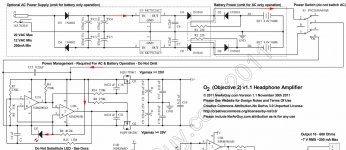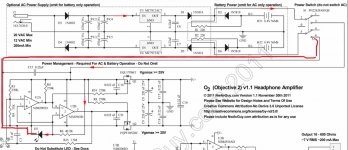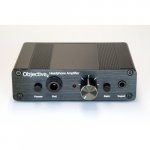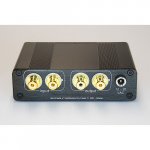My ODAC is in an external case, so I do not need to switch between Line-Out and Audio-Out, but it is good to know.
They are not the kind of jumper one knows from hard drives, they are just two contacts with a little space between them, that is where you solder them together.
You can see them on the document you posted on top of the pages 4 and 5, they are J1 and J2.
Without these jumpers there is only a signal on the Line-Out, but I needed the Audio-Out for the external case.
They are not the kind of jumper one knows from hard drives, they are just two contacts with a little space between them, that is where you solder them together.
You can see them on the document you posted on top of the pages 4 and 5, they are J1 and J2.
Without these jumpers there is only a signal on the Line-Out, but I needed the Audio-Out for the external case.
Those PCB traces (joints) from pag. 4: http://www.jdslabs.com/pdf/Custom O2-ODAC - Complete Soldering Guide.pdf ? I get it now...however, just be sure you don't mix 2 input sources at once, so either the input jack should be disconnected while audio_out has a source connected, either you install a switch.
Thanks Mooly for your reply (post 5144)
I'm having some hard time understanding the negative voltage rail and the 7912 voltage regulator operation in the circuit. I don't know if this is a dumb question, but where does the current flow after going through the led D7? (see attachment)
I'm having some hard time understanding the negative voltage rail and the 7912 voltage regulator operation in the circuit. I don't know if this is a dumb question, but where does the current flow after going through the led D7? (see attachment)
Attachments
I'd suggest to try equal value 1...2kohm resistors on the input and feedback loop as Douglas Self did, or 100 kohm as in Nakamichi CR4 if you want a different flavour .It's definetly worth trying the Nak 4556 output version and some know what i'm talking about.I don't really like the sound of njm4556 in unity gain configureation though.A bit of gain brings it to life.Actually some reputable manufacturers, like Denon used njm4556 at 20x gains and than substracted the output oltage with a resistor in series with the headphones and they knew what they were doing.
Otherwise it's nothing special about njm4556 no matter how you use it.It's a really good amp for headphones, i had it built in many of my amplifiers, decks and players,i am in good relationships with it , but if i compare , not to a specialized ic like tpa6120 , just to my kenwood A65 power amplifier on the headphones output, there's no match.Allmost any power amplifier will blow away njm4556 as with the normal currents involved it's running pure class a and the sound is way better than allmost any small ic.Not all the amplifiers take beneffit from very low noise transistors on the input and that makes some amplifiers too noisy for headphones.Unfortunately the people forgot that most decent power amplifiers derived their headphones output from the power amplifier output and the slew rate and output voltage is enough for any headphones outhere(except esl).Buy a high end vintage amplifier and use it's headphones output and you'll never look for a separate headphones amplifier unless it's part of a specialist amplifier or console.Plus you have a power amplifier too.My small , cheap Kenwood on Bayerdynamic dt880 pro sounds perfect and i did build some good headphones amplifier :valves opt ant opt-less , tpa6120, drv134 class a with bd139, 140, and nothing can beat the Kenwood while this is just a cheap amplifier and there are much better amplifiers outhere.
Otherwise it's nothing special about njm4556 no matter how you use it.It's a really good amp for headphones, i had it built in many of my amplifiers, decks and players,i am in good relationships with it , but if i compare , not to a specialized ic like tpa6120 , just to my kenwood A65 power amplifier on the headphones output, there's no match.Allmost any power amplifier will blow away njm4556 as with the normal currents involved it's running pure class a and the sound is way better than allmost any small ic.Not all the amplifiers take beneffit from very low noise transistors on the input and that makes some amplifiers too noisy for headphones.Unfortunately the people forgot that most decent power amplifiers derived their headphones output from the power amplifier output and the slew rate and output voltage is enough for any headphones outhere(except esl).Buy a high end vintage amplifier and use it's headphones output and you'll never look for a separate headphones amplifier unless it's part of a specialist amplifier or console.Plus you have a power amplifier too.My small , cheap Kenwood on Bayerdynamic dt880 pro sounds perfect and i did build some good headphones amplifier :valves opt ant opt-less , tpa6120, drv134 class a with bd139, 140, and nothing can beat the Kenwood while this is just a cheap amplifier and there are much better amplifiers outhere.
Last edited:
Thanks Mooly for your reply (post 5144)
I'm having some hard time understanding the negative voltage rail and the 7912 voltage regulator operation in the circuit. I don't know if this is a dumb question, but where does the current flow after going through the led D7? (see attachment)
The LED current returns into the negative rail like this. The 7812 generates a stable and clean plus 12 volt rail and the 7912 generates a minus 12 volt rail.
The LED and its series resistor are wired across this supply which is 24 volts in total.
Attachments
My O2 desktop amp has developed an odd sounding problem...
It sounds like there is a little gap in the 'sound-stage', just left of centre.
Left channel sounds like the signal is up higher than the right.
Both channels work, fed a source via RCA or 3.5mm TRS inputs, and the problem shows up on RCA and 3.5mm outputs. I've tried different cables, cans, adapters, gain settings and sources, and experience same problem no matter what is used. It's a head'n'hifi O2 from Stefan.
I do recall once hearing of a resistor short, or the corner of a PCB hitting something near the volume pot? Maybe on NwAvGuy's page, which is hard to navigate.
I can't get inside the O2 at the moment to take any measurements or pictures, for lack of bits to open the case.
Has anyone here experienced a similar thing?
Thanks.
It sounds like there is a little gap in the 'sound-stage', just left of centre.
Left channel sounds like the signal is up higher than the right.
Both channels work, fed a source via RCA or 3.5mm TRS inputs, and the problem shows up on RCA and 3.5mm outputs. I've tried different cables, cans, adapters, gain settings and sources, and experience same problem no matter what is used. It's a head'n'hifi O2 from Stefan.
I do recall once hearing of a resistor short, or the corner of a PCB hitting something near the volume pot? Maybe on NwAvGuy's page, which is hard to navigate.
I can't get inside the O2 at the moment to take any measurements or pictures, for lack of bits to open the case.
Has anyone here experienced a similar thing?
Thanks.
I've heard of something around the gain switch causing a short... something like that should be easy to find though.
A couple of quick checks with a scope and a signal source would reveal any issues. You need to check gain of course and also check for any odd crosstalk effects.
A couple of quick checks with a scope and a signal source would reveal any issues. You need to check gain of course and also check for any odd crosstalk effects.
The fact you can swap the IC between channels and move the noise between channels suggests the 2068 could be faulty. These parts cost very little and so I would just replace it and be certain.
Follow up:
I replaced the 2068 IC, and my amp is back to the really quite way it was! Thanks for helping!
However, I do have some questions that I'd like to get your ideas from.
The NJM2068 op amp that I ordered from an online store, was labeled as NJM2068D, but the actual IC is labeled as NJM2068DD. I think this shouldn't be a problem, as according to my highly unscientific testing with my laptop and my own hearing, my O2 works just fine, but curious to know the differences between the two models, I viewed the document from NJR, and all the document says is "The D-Rank type products(NJM2068DD/LD/MD) have specified maximum limits for equivalent input noise voltage." without further information on each model. So are you aware of any differences between these models?
Also, not quite sure whether or not related to the new op amp, but I think did accidentally clip the O2 for the very first time with the headphone output of my laptop, as I heard some distortion which disappeared when I turned the volume of my laptop lower and volume of O2 higher.
One other question is, when I was looking for parts in case my O2 breaks again in the future, or if I want to build another one myself, I found the power indicator led, which I remember mentioned my NWAVGuy specifically in his post shouldn't be replaced by any other led light, went out of stock on mouser. What are the special specification of that led that makes it special, so to speak, and what are some other models of parts that can replace this led?
Thanks again for helping me to solve the noise issue!
The different models refer to the package styles. D is DIP 8, M is a surface mount, and L is the SIL (single in-line).
The D noise grade is a specifiction that only applies to those packages. The other V package (small surface mount) is not graded.
So DD just means 8 pin DIP with the D noise rank. There is no choice or alternative, they are all the same.
The LED is one of the design flaws of the O2 because it ties the design to a very specific part.
Have a read at this for how to use a different LED:
The Objective2 (O2) Headphone Amp DIY Project
The D noise grade is a specifiction that only applies to those packages. The other V package (small surface mount) is not graded.
So DD just means 8 pin DIP with the D noise rank. There is no choice or alternative, they are all the same.
The LED is one of the design flaws of the O2 because it ties the design to a very specific part.
Have a read at this for how to use a different LED:
The Objective2 (O2) Headphone Amp DIY Project
Follow up:
One other question is, when I was looking for parts in case my O2 breaks again in the future, or if I want to build another one myself, I found the power indicator led, which I remember mentioned my NWAVGuy specifically in his post shouldn't be replaced by any other led light, went out of stock on mouser. What are the special specification of that led that makes it special, so to speak, and what are some other models of parts that can replace this led?
JDS Labs sell the exact model of LED at an unlisted product page (out of courtesy, I cannot publicly post it here). If you message them via their contact page, they will likely point you to it. Typically, they sell them at around $0.50 each plus $3.00-$4.00 for shipping. JDS Labs will always have them since they buy them, likely in special order large volume quantities, for their own O2s which they manufacture.
Last edited:
I've heard of something around the gain switch causing a short... something like that should be easy to find though.
A couple of quick checks with a scope and a signal source would reveal any issues. You need to check gain of course and also check for any odd crosstalk effects.
Thanks Mooly for the reply.
I've no scope here, I'll have to fix it by other means, shouldn't be too hard.
If I could just get inside the unit...
As Stefan has not seen fit to reply to my email, I wonder if anyone here can ID the type of bit used to open the case on Stefan's Head n HiFi desktop O2?
Anyone else notice the rear RCA in/outs are around backward to the way they should be? PCB layout should be from the front/top, and like a book it reads from the left, which puts Stefan's RCA sockets around backward to other HiFi gear.
Anyway, I've a fairly large selection of screwdriver bits, hex, torx and others but I've not been able to locate one that fits the O2 desktop amp.
If anyone can ID the type of bit required, or has opened one of these before, that would be great!
Any info appreciated.
Hopefully my picture attachments work...
Attachments
From NwAvGuys construction tips:
S2 PROBLEM – The September version of the PCB artwork (9/14/11 release) has the via between R21 and S2 located too close to the corner “foot” on S2. While most have not had any problem, it’s highly recommended to slightly bend the leg in that corner of the switch inward, or if you have some heavy cutters, trim that leg shorter (don’t use small “precision” cutters as you’ll likely damage the blades). At the least, make sure there is no contact when you’re soldering S2 in place.
About the screws, usually these are torx T8. And I don't understand why you think your RCAs are backward, they seem to reed L - R from left to right?
Rgrds
S2 PROBLEM – The September version of the PCB artwork (9/14/11 release) has the via between R21 and S2 located too close to the corner “foot” on S2. While most have not had any problem, it’s highly recommended to slightly bend the leg in that corner of the switch inward, or if you have some heavy cutters, trim that leg shorter (don’t use small “precision” cutters as you’ll likely damage the blades). At the least, make sure there is no contact when you’re soldering S2 in place.
About the screws, usually these are torx T8. And I don't understand why you think your RCAs are backward, they seem to reed L - R from left to right?
Rgrds
Thanks for the reply CHiroshi!
I couldn't find that piece of text at NwAvGuy's site, even though I'm sure I had read it before. Thanks again.
I will look into those torx bits (my set were too large) and that mod you mention and see if it is indeed the problem I have and report back with pics and repairs. Torx is not as common in Australia really, as other places. I see torx mostly on European imported cars here.
Edit: Aha, I've just heard from Stefan, a Torx T8 and a 1.27mm allen key for the volume knob, excellent work Stefan!
Re: RCA orientation
The RCA orientation is probably a silk screening error on Head n Hifi desktop O2s, it's a minor quibble really.
I carry my O2 with a mobile recording rig and often I am fumbling around the rear panel of USB interfaces (in the dark) and the O2 and notice their RCA orientation is inverted.
Just plugging in HiFi gear and mixing consoles for decades, when one leans over the back of gear to plug RCA cables in/out, rear RCAs are viewed (when viewed from above the piece of gear) from Left to right, (following PCB orientation) not when the gear is turned around with the rear panel facing the user, which is kind of inconvenient for remotes and control access! RCAs in rows usually look - White, Red, White Red, White, Red, for Amps, interfaces, DACs, all in rows, until you look at the O2 and it's the other way around, Red, White... if I've explained that well enough...
The O2 just looks odd sitting in a stack where it has the RCA cables colour codes inverted, makes me want to check polarity all the time!
Pics will show an example of standard RCA layouts (Yamaha).vs the O2.
If my picture attachments work this time...
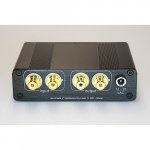
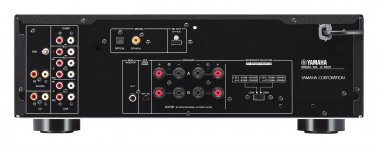
I couldn't find that piece of text at NwAvGuy's site, even though I'm sure I had read it before. Thanks again.
I will look into those torx bits (my set were too large) and that mod you mention and see if it is indeed the problem I have and report back with pics and repairs. Torx is not as common in Australia really, as other places. I see torx mostly on European imported cars here.
Edit: Aha, I've just heard from Stefan, a Torx T8 and a 1.27mm allen key for the volume knob, excellent work Stefan!
Re: RCA orientation
The RCA orientation is probably a silk screening error on Head n Hifi desktop O2s, it's a minor quibble really.
I carry my O2 with a mobile recording rig and often I am fumbling around the rear panel of USB interfaces (in the dark) and the O2 and notice their RCA orientation is inverted.
Just plugging in HiFi gear and mixing consoles for decades, when one leans over the back of gear to plug RCA cables in/out, rear RCAs are viewed (when viewed from above the piece of gear) from Left to right, (following PCB orientation) not when the gear is turned around with the rear panel facing the user, which is kind of inconvenient for remotes and control access! RCAs in rows usually look - White, Red, White Red, White, Red, for Amps, interfaces, DACs, all in rows, until you look at the O2 and it's the other way around, Red, White... if I've explained that well enough...
The O2 just looks odd sitting in a stack where it has the RCA cables colour codes inverted, makes me want to check polarity all the time!
Pics will show an example of standard RCA layouts (Yamaha).vs the O2.
If my picture attachments work this time...


Last edited:
I am very close to starting my build of my extreme/no compromise edition Objective2 and I have one final question regarding the gain stage opamp, U1. AGDR notes the following:
I noticed elsewhere in this thread that others (for example, here) have tried using the LM4562/LME49720/LME49860 as an upgrade without much feedback on results (hopefully, no news is good news). Would that particular opamp work here without said oscillations?
Update 2: Other chips for the gain stage. So far every other dual audio-specified op-amp I've tried in place of the NJM2068 has oscillated. I don't currently have an alternate recommendation. This includes the OPA1612, TI's flagship low-noise and low-THD bipolar audio chip. If some one is aware of a chip with better specs than the NJM2068 that doesn't oscilalte, please send a note at the contact link!
I noticed elsewhere in this thread that others (for example, here) have tried using the LM4562/LME49720/LME49860 as an upgrade without much feedback on results (hopefully, no news is good news). Would that particular opamp work here without said oscillations?
Last edited:
The gain stage is all text book stuff and I would have thought 'any' typical audio chip would work just fine.
That's said, the devil is in the detail. Perhaps the PCB layout introduces some stray capacitive coupling somewhere, or the volume control likewise. Perhaps a small isolation resistor is need on the opamp output, or maybe decoupling isn't good enough for a high speed replacement.
That's said, the devil is in the detail. Perhaps the PCB layout introduces some stray capacitive coupling somewhere, or the volume control likewise. Perhaps a small isolation resistor is need on the opamp output, or maybe decoupling isn't good enough for a high speed replacement.
The gain stage is all text book stuff and I would have thought 'any' typical audio chip would work just fine.
That's said, the devil is in the detail. Perhaps the PCB layout introduces some stray capacitive coupling somewhere, or the volume control likewise. Perhaps a small isolation resistor is need on the opamp output, or maybe decoupling isn't good enough for a high speed replacement.
Thanks, Mooly! I think will give it a try (will need to place another order to get the opamp) and see if the DC offset and operating temperatures are affected and, if not, if I detect any audible problems (unfortunately, I have no o-scope).
I have no means to observe oscillations other than by measuring the chips' temperatures. But I've tried a few different opamps other than the 2068 in the gain stage and these are my observations:I am very close to starting my build of my extreme/no compromise edition Objective2 and I have one final question regarding the gain stage opamp, U1. AGDR notes the following:
I noticed elsewhere in this thread that others (for example, here) have tried using the LM4562/LME49720/LME49860 as an upgrade without much feedback on results (hopefully, no news is good news). Would that particular opamp work here without said oscillations?
Did get much warmer (over 60°C): LME49990 x2 on adapter, AD797 x2 on adapter
Did get slightly warmer (around 42-43°C): LME49720, OPA2604
As cool as the 2068 (around 39-40°C): 5532 (JRC and TI), MUSES8820, NJM4560, OPA2134, OPA2227, MC33078
I used the MUSES8820 for a period of time, but I reverted to the 2068. Generally I couldn't hear any difference between the different opamps, even the ones oscillating!...
Not sure about the middle group, whether they just get slightly warmer because of higher current draw, or if it is some mild case of oscillation.
I have no means to observe oscillations other than by measuring the chips' temperatures. But I've tried a few different opamps other than the 2068 in the gain stage and these are my observations:
Did get much warmer (over 60°C): LME49990 x2 on adapter, AD797 x2 on adapter
Did get slightly warmer (around 42-43°C): LME49720, OPA2604
As cool as the 2068 (around 39-40°C): 5532 (JRC and TI), MUSES8820, NJM4560, OPA2134, OPA2227, MC33078
I used the MUSES8820 for a period of time, but I reverted to the 2068. Generally I couldn't hear any difference between the different opamps, even the ones oscillating!...
Not sure about the middle group, whether they just get slightly warmer because of higher current draw, or if it is some mild case of oscillation.
Cool! I just got a Sennheiser HD 800 which is why I am being very particular about this build since I have been surprised by how detailed and revealing it is. Even with things that I have been told for years should not make any difference, I have been able to hear the most minute of problems. For example, I have discovered that there are likely truncation issues (verified with blind tests of myself and others; I surmise that either [a] these Realtek codecs was never designed for exclusive mode in the first place or there are serious buffer under-run issues with foobar2000’s WASAPI implementation) when using Wasapi (event and push exclusive modes) instead of Directsound in Foobar2000 with my Surface Pro 4. When people say it is a “sonic microscope,” they were not kidding.
Nwavguy.com is due for a domain renewal on the 9th of this month. Will he step out of the shadows ever again or simply do his seasonal domain renewal whilst leaving his legacy at a close?
| ICANN WHOIS
| ICANN WHOIS
- Home
- Amplifiers
- Headphone Systems
- The Objective2 (O2) Headphone Amp DIY Project
